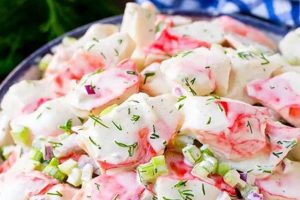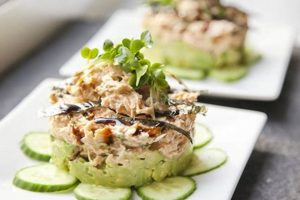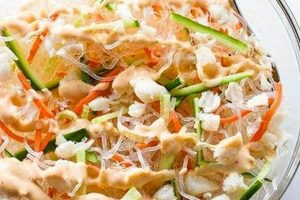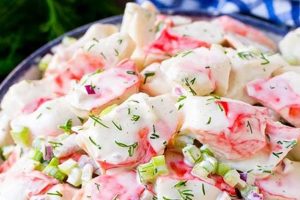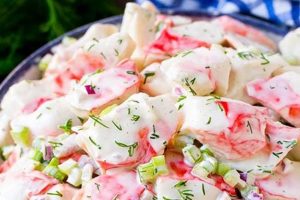A superior crab salad involves a delicate balance of high-quality ingredients and skillful preparation. Typically, this includes fresh crab meat, a flavorful binder (often mayonnaise-based), and carefully selected seasonings and additions like celery, onion, or herbs. An exemplary version might feature lump crab meat, a light dressing of mayonnaise and Dijon mustard, finely diced celery and red onion, a touch of lemon juice, and fresh dill.
Achieving excellence in this dish offers numerous culinary rewards. A well-executed preparation highlights the natural sweetness of the crab while offering a refreshing and satisfying experience. Historically, crab salad has evolved from simple preparations using readily available ingredients to more refined versions showcasing culinary creativity. Its continued popularity stems from its versatility as a standalone dish, sandwich filling, or appetizer component.
The following sections will explore various aspects of creating an exceptional crab salad, covering ingredient selection, preparation techniques, variations, and serving suggestions to ensure a delightful culinary outcome.
Tips for an Exceptional Crab Salad
Creating a truly remarkable crab salad requires attention to detail and an understanding of key principles. The following tips offer guidance for elevating this dish from ordinary to extraordinary.
Tip 1: Prioritize Fresh, High-Quality Crab Meat: Opting for the freshest crab meat available significantly impacts the final flavor. Lump or jumbo lump crab meat is recommended for its superior texture and taste.
Tip 2: Exercise Restraint with the Binder: The binder should complement, not overwhelm, the delicate crab flavor. A light hand with mayonnaise, or a combination of mayonnaise and Greek yogurt, ensures the crab remains the star.
Tip 3: Add Crunch and Brightness: Finely diced celery, red onion, or bell pepper contribute textural contrast and a refreshing element. A touch of acidity from lemon or lime juice further enhances the overall flavor profile.
Tip 4: Season Judiciously: Simple seasonings, such as Old Bay, dill, paprika, or a pinch of cayenne pepper, can elevate the crab’s natural sweetness without overpowering it. Salt and freshly ground black pepper are essential for balance.
Tip 5: Chill Thoroughly Before Serving: Chilling the crab salad allows the flavors to meld and creates a more refreshing experience. Aim for at least 30 minutes of refrigeration before serving.
Tip 6: Consider Complementary Ingredients: Avocado, chopped hard-boiled eggs, or fresh herbs like parsley or chives can add complexity and visual appeal.
Tip 7: Choose Serving Vessels Wisely: Serve the crab salad on crisp lettuce cups, toasted bread, crackers, or as a filling for deviled eggs for an elegant presentation.
By adhering to these guidelines, one can achieve a crab salad that showcases the inherent qualities of the crab while delivering a sophisticated and satisfying culinary experience.
Through careful ingredient selection and thoughtful preparation, a truly memorable crab salad can be achieved, delighting the palate and leaving a lasting impression.
1. Fresh, High-Quality Crab
Fresh, high-quality crab forms the cornerstone of a superior crab salad. Its importance cannot be overstated, as the crab itself dictates the overall flavor and texture of the final product. The inherent sweetness and delicate texture of fresh crab meat shine through when minimally processed and lightly seasoned. Conversely, using lower-quality, pre-cooked, or heavily processed crab often results in a fishy taste, rubbery texture, and an overall diminished culinary experience. Consider the difference between a salad made with freshly picked lump crab meat versus one using canned, shredded crab. The former offers a clean, bright flavor and pleasing texture, while the latter often presents a compromised flavor profile and a less desirable consistency.
The impact of crab quality extends beyond taste and texture. Fresh crab generally contains less sodium and preservatives than processed alternatives, aligning with health-conscious preferences. Furthermore, using premium crab meat enhances the perceived value of the dish, elevating it from a simple salad to a more refined culinary creation. This is particularly relevant in professional settings, where restaurants or caterers prioritize fresh, high-quality ingredients to provide a superior dining experience. In home kitchens, utilizing the best available crab meat reflects a commitment to quality and enhances the enjoyment of a meal.
Prioritizing fresh, high-quality crab ensures the best possible foundation for an exceptional crab salad. This emphasis on ingredient quality directly translates to a superior final product, impacting flavor, texture, and overall dining experience. Challenges may arise in sourcing truly fresh crab, particularly in inland areas. However, seeking out reputable fishmongers or exploring frozen, high-quality options can provide viable solutions. Ultimately, the quality of the crab used fundamentally determines the potential of the salad, underscoring its crucial role in the pursuit of culinary excellence.
2. Balanced, Flavorful Binder
The binder in a crab salad plays a crucial role, binding the ingredients while contributing to the overall flavor profile. A balanced, flavorful binder enhances the crab’s natural sweetness without overpowering it. An improper binder can ruin the dish, either by masking the delicate crab flavor or creating an unpleasant textural experience.
- Mayonnaise-Based Binders:
Classic crab salad often relies on mayonnaise as the primary binder. High-quality mayonnaise provides a creamy texture and a tangy flavor that complements the sweetness of the crab. However, excessive mayonnaise can create a heavy, overly rich salad. A balanced approach utilizes just enough mayonnaise to bind the ingredients without dominating the flavor profile. Variations include incorporating Dijon mustard, aioli, or flavored mayonnaises for added complexity.
- Dairy-Based Alternatives:
Greek yogurt or crme frache offer lighter alternatives to mayonnaise. These options contribute a tangy flavor and creamy texture while reducing the overall fat content. They also provide a blank canvas for incorporating additional flavors through herbs, spices, or citrus zest. The lower fat content allows the delicate crab flavor to shine through, while the tanginess adds a refreshing counterpoint to the sweetness.
- Vinaigrettes:
A light vinaigrette offers a refreshing, less creamy alternative for binding crab salad. A simple lemon vinaigrette, for example, enhances the crab’s natural sweetness with a bright, acidic note. This approach creates a lighter, more delicate salad suitable for warmer weather or those seeking a lower-calorie option. The vinaigrette’s acidity also helps to preserve the vibrant color of the crab meat.
- Emulsified Sauces:
More complex emulsified sauces, such as a remoulade or aioli, offer nuanced flavor profiles and luxurious textures. These sauces can incorporate various ingredients like capers, pickles, herbs, and spices, adding depth and complexity to the crab salad. The emulsion provides a smooth, creamy texture that coats the crab meat evenly, ensuring a balanced distribution of flavor.
Ultimately, the choice of binder significantly influences the final character of the crab salad. Selecting a binder that complements the crab’s delicate flavor while providing the desired texture is essential for achieving a harmonious and delicious result. Whether opting for a classic mayonnaise-based approach or exploring lighter, brighter alternatives, a balanced and flavorful binder remains a cornerstone of a truly exceptional crab salad.
3. Crisp, Complementary Vegetables
The incorporation of crisp, complementary vegetables is essential for achieving a balanced and flavorful crab salad. These vegetables contribute textural contrast, a refreshing element, and often subtle aromatic notes that enhance the overall sensory experience. Their careful selection and preparation are critical for elevating a crab salad from satisfactory to exceptional.
- Celery
Celery offers a classic textural counterpoint to the softness of the crab meat. Its slightly bitter, herbaceous notes provide a refreshing contrast to the crab’s sweetness. Finely diced celery is the standard, ensuring even distribution throughout the salad. However, thinly sliced celery can offer a more pronounced crunch.
- Red Onion
Red onion provides a sharp, pungent bite that cuts through the richness of the crab and binder. Its vibrant color also adds visual appeal. Finely diced red onion is preferred, as larger pieces can overwhelm the delicate crab flavor. Soaking the diced onion in cold water for a few minutes can mellow its pungency while maintaining its crispness.
- Bell Pepper
Bell peppers, particularly red or yellow, introduce a subtle sweetness and a vibrant color contrast. Their crisp texture provides another layer of textural complexity. Finely diced bell pepper complements the other vegetables, adding a subtle vegetal sweetness without dominating the flavor profile.
- Jalapeo or other Chili Peppers
A small amount of finely diced jalapeo or other chili pepper introduces a touch of heat, adding a dynamic layer of flavor. This spicy element contrasts beautifully with the sweetness of the crab and the coolness of the binder. Careful control of the quantity is crucial, as excessive heat can easily overpower the delicate crab flavor.
The strategic inclusion of crisp, complementary vegetables is integral to crafting a well-balanced crab salad. These elements contribute not only textural variety and visual appeal but also subtle flavors that enhance the overall composition. By carefully considering the interplay of textures, flavors, and colors, one can achieve a crab salad that is both refreshing and deeply satisfying. The proper balance of these vegetables ensures that the inherent qualities of the crab meat remain prominent while benefiting from the complexity and contrast provided by the vegetable components.
4. Subtle, Enhancing Seasonings
Seasonings play a pivotal role in elevating a crab salad from simple to exceptional. The operative word here is “subtle.” Over-seasoning easily masks the delicate sweetness of fresh crab, the very essence of the dish. Enhancing seasonings, on the other hand, complement and amplify the natural flavors without overpowering them. Consider the difference between a crab salad seasoned solely with copious amounts of Old Bay seasoning versus one with a judicious pinch of Old Bay balanced by fresh dill and a squeeze of lemon. The latter allows the crab flavor to shine, supported by complementary notes that add depth and complexity.
Several seasonings consistently contribute positively to crab salad recipes. Fresh dill, with its bright, slightly citrusy aroma, pairs beautifully with the sweetness of the crab. A touch of Old Bay seasoning offers a savory blend of spices, often including celery salt, paprika, and mustard powder, echoing flavors often found in complementary vegetables. Lemon zest or juice contributes brightness and acidity, balancing the richness of the binder and enhancing the crab’s freshness. A small amount of cayenne pepper can introduce a subtle warmth, adding another dimension to the flavor profile. High-quality sea salt and freshly ground black pepper provide foundational seasoning, enhancing the overall flavor experience.
Achieving a harmonious blend of seasonings requires careful consideration and a light hand. Start with small amounts, tasting and adjusting incrementally until the desired balance is achieved. The goal is to create a symphony of flavors where the crab remains the star, supported by a chorus of complementary seasonings. Over-reliance on any single seasoning can disrupt this delicate balance, obscuring the natural flavors of the crab and other ingredients. Understanding the nuances of various seasonings and their interplay with the other components of a crab salad allows for a thoughtful approach to flavor development, resulting in a more refined and satisfying culinary experience. This delicate balancing act between showcasing the crab’s inherent flavor and enhancing it with complementary seasonings ultimately defines the success of a truly exceptional crab salad.
5. Proper Chilling and Resting
Proper chilling and resting are critical steps often overlooked in achieving a truly exceptional crab salad. This period of refrigeration allows the flavors of the various componentsthe delicate crab, the binder, the vegetables, and the seasoningsto meld and harmonize. Immediately after preparation, individual flavors may stand out, creating a less cohesive experience. Chilling allows these distinct elements to integrate, resulting in a more balanced and nuanced flavor profile. Consider a freshly made crab salad where the sharpness of the red onion or the tanginess of the lemon juice dominates. After an adequate chilling period, these flavors mellow and integrate with the other ingredients, creating a more harmonious overall taste.
Beyond flavor development, chilling also impacts the texture of the crab salad. A chilled salad presents a firmer, more refreshing texture, particularly when using mayonnaise-based binders. The chilling process allows the binder to set, preventing a watery or loose consistency. This textural improvement enhances the overall eating experience, offering a more pleasant mouthfeel. A warm crab salad, conversely, may exhibit a less desirable, softer texture, particularly noticeable in warmer climates. The practical significance becomes readily apparent when serving the salad: a chilled salad maintains its structural integrity, whether served in a delicate lettuce cup or atop a toasted baguette slice.
The optimal chilling time for crab salad is generally between 30 minutes to an hour. This duration provides sufficient time for flavor development and textural improvement without compromising the integrity of the ingredients. Over-chilling, however, can negatively impact the delicate flavors and textures. Therefore, achieving the “best crab salad recipe” necessitates not only carefully selected ingredients and precise preparation but also an understanding of the essential role played by proper chilling and resting. This final step, often overlooked, allows the carefully crafted flavors and textures to reach their full potential, culminating in a truly exceptional culinary experience.
6. Thoughtful Presentation
Thoughtful presentation elevates crab salad from a simple dish to a culinary experience. Visual appeal significantly influences perception of flavor and overall enjoyment. A thoughtfully presented crab salad entices the diner, creating anticipation and enhancing the perceived value of the dish. Consider the difference between a mound of crab salad sloppily placed on a plate versus the same salad delicately arranged in crisp lettuce cups, garnished with fresh herbs and a sprinkle of paprika. The latter presentation immediately suggests a higher level of care and attention to detail, creating a more positive dining experience before the first bite is even taken.
Several factors contribute to a thoughtful presentation. The choice of serving vessel plays a crucial role. Options range from classic lettuce cups and toasted baguette slices to more elaborate presentations using avocado halves or hollowed-out tomatoes. Garnishes contribute significantly to visual appeal and can also complement the flavors of the salad. Fresh herbs like dill or parsley, a sprinkle of paprika, or a drizzle of olive oil add color and visual interest. Portion size also influences presentation. Overly large portions can appear overwhelming, while smaller, more manageable portions often convey a sense of refinement. The arrangement of the salad itself matters. A neatly mounded salad or a carefully layered presentation appears more appealing than a haphazardly arranged pile. In professional settings, such as restaurants or catering events, meticulous plating enhances the perceived value and professionalism of the offering. Even in home kitchens, a thoughtfully presented crab salad elevates a simple meal, demonstrating care and attention to detail.
The connection between thoughtful presentation and the “best crab salad recipe” lies in the understanding that culinary excellence encompasses both flavor and aesthetics. While high-quality ingredients and skillful preparation form the foundation of a great dish, thoughtful presentation completes the experience, elevating it from merely palatable to truly memorable. Challenges may include time constraints or limited resources. However, even simple garnishes and attention to plating can significantly enhance the final presentation. Ultimately, recognizing the integral role of presentation in achieving a superlative crab salad demonstrates a comprehensive understanding of culinary artistry, where visual appeal and flavor harmonize to create a truly satisfying dining experience.
7. Appropriate Serving Vessels
The selection of appropriate serving vessels contributes significantly to the overall enjoyment of crab salad, impacting both presentation and practicality. Serving vessels should complement the delicate flavors and textures of the salad while also considering the context of the meal, whether a casual lunch or a more formal occasion. The right vessel enhances the dining experience, while an inappropriate choice can detract from even the most skillfully prepared crab salad. Choosing the correct serving method affects both the perceived quality and the ease of consumption.
- Classic Options
Traditional serving options include crisp lettuce cups, providing a refreshing, light counterpoint to the richness of the crab salad. Toasted baguette slices or crackers offer a crunchy base that complements the salad’s creamy texture. These classic choices are versatile and appropriate for various occasions, from casual gatherings to more formal settings. They offer structural integrity for easy handling while also contributing complementary flavors and textures.
- Elegant Alternatives
For more elegant presentations, consider serving crab salad in avocado halves, offering a creamy, visually appealing vessel that complements the crab’s flavor. Hollowed-out tomatoes provide a vibrant, refreshing option, particularly during summer months. These choices add an element of sophistication and enhance the perceived value of the dish. They also introduce complementary flavors and textures that further enrich the dining experience. However, such options might be less practical for large gatherings or casual settings.
- Practical Considerations
Practicality plays a role in selecting serving vessels, particularly for larger gatherings or buffet-style service. Small bowls or ramekins offer individual portions, minimizing mess and maximizing convenience. Larger platters, garnished appropriately, are suitable for shared servings. Considerations include ease of serving, portion control, and the overall flow of the meal. These practical aspects, while seemingly mundane, significantly impact the enjoyment of the dish, particularly in situations where ease of service and consumption are paramount.
- Creative Presentations
Creative presentations can further elevate the crab salad experience. Consider serving the salad in hollowed-out cucumber cups or as a filling for deviled eggs. These imaginative approaches add visual interest and can introduce unexpected flavor combinations. Such presentations are particularly well-suited for special occasions or when seeking to impress guests. However, they often require more preparation time and effort, making them less practical for everyday meals or large gatherings.
The selection of appropriate serving vessels, while often an afterthought, represents a crucial element in realizing the “best crab salad recipe.” The chosen vessel should not only complement the flavors and textures of the salad but also enhance the overall dining experience. Whether prioritizing classic elegance, practical convenience, or creative flair, the serving vessel contributes significantly to the perception and enjoyment of this versatile dish. By carefully considering these aspects, one can ensure that the chosen vessel enhances, rather than detracts from, the culinary experience, ultimately contributing to the creation of a truly exceptional crab salad.
Frequently Asked Questions
This section addresses common inquiries regarding the preparation and enjoyment of superior crab salad.
Question 1: What type of crab meat is best suited for crab salad?
Lump or jumbo lump crab meat is generally preferred for its superior texture and flavor. These grades contain larger, more intact pieces of crab meat, resulting in a more luxurious and visually appealing salad. While other grades, such as backfin or claw meat, can be used, they often result in a finer, less desirable texture.
Question 2: How can one ensure the crab meat is fresh?
Sourcing crab meat from reputable fishmongers is crucial. Inquire about the crab’s origin and processing methods. Fresh crab meat should exhibit a clean, sweet aroma and a firm, moist texture. Avoid crab meat with a fishy odor or a slimy appearance. When purchasing pre-packaged crab meat, carefully check the expiration date and ensure proper refrigeration.
Question 3: What is the ideal ratio of crab meat to binder?
The optimal ratio depends on personal preference and the specific binder used. Generally, a lighter hand with the binder is recommended, allowing the crab flavor to shine. A starting point might be a 2:1 ratio of crab meat to binder, adjusting according to taste and the desired consistency.
Question 4: Can crab salad be prepared in advance?
Crab salad is best served fresh; however, it can be prepared a few hours in advance. After preparation, cover and refrigerate immediately to maintain freshness and prevent bacterial growth. Allow the salad to rest for at least 30 minutes before serving to allow the flavors to meld.
Question 5: How long can crab salad be stored in the refrigerator?
Crab salad should be consumed within two days of preparation, even when properly refrigerated. Store the salad in an airtight container to prevent it from absorbing odors from other foods and to maintain its moisture content. Discard any salad that exhibits a sour odor or a change in texture.
Question 6: What are some common serving suggestions beyond the typical bread or crackers?
Crab salad offers versatility beyond traditional accompaniments. Consider serving it in lettuce cups, avocado halves, or hollowed-out tomatoes. It can also be used as a filling for deviled eggs or as a topping for grilled fish or vegetables. These alternatives provide varied textures and flavors that complement the crab salad.
By addressing these frequently asked questions, individuals can gain a deeper understanding of the nuances involved in selecting, preparing, and enjoying a superior crab salad. Attention to detail, from ingredient selection to presentation, ultimately contributes to a more satisfying culinary experience.
The following section explores variations on the classic crab salad recipe, offering creative twists and flavor combinations to further enhance enjoyment of this versatile dish.
Best Crab Salad Recipe
Achieving a truly exceptional crab salad requires a nuanced understanding of key elements: prioritizing fresh, high-quality crab meat; selecting a balanced, flavorful binder; incorporating crisp, complementary vegetables; employing subtle, enhancing seasonings; allowing proper chilling and resting time; and attending to thoughtful presentation, including the selection of appropriate serving vessels. Each component contributes significantly to the final product, impacting flavor, texture, and overall dining experience.
Culinary exploration extends beyond simply following a recipe. It involves a deeper understanding of ingredients and techniques, allowing for adaptation and personalization. The pursuit of the best crab salad recipe represents a journey of culinary discovery, where experimentation and refinement lead to a truly rewarding and personalized outcome. The potential for variation and creativity within this seemingly simple dish offers a continuous opportunity for culinary growth and the creation of memorable dining experiences.

